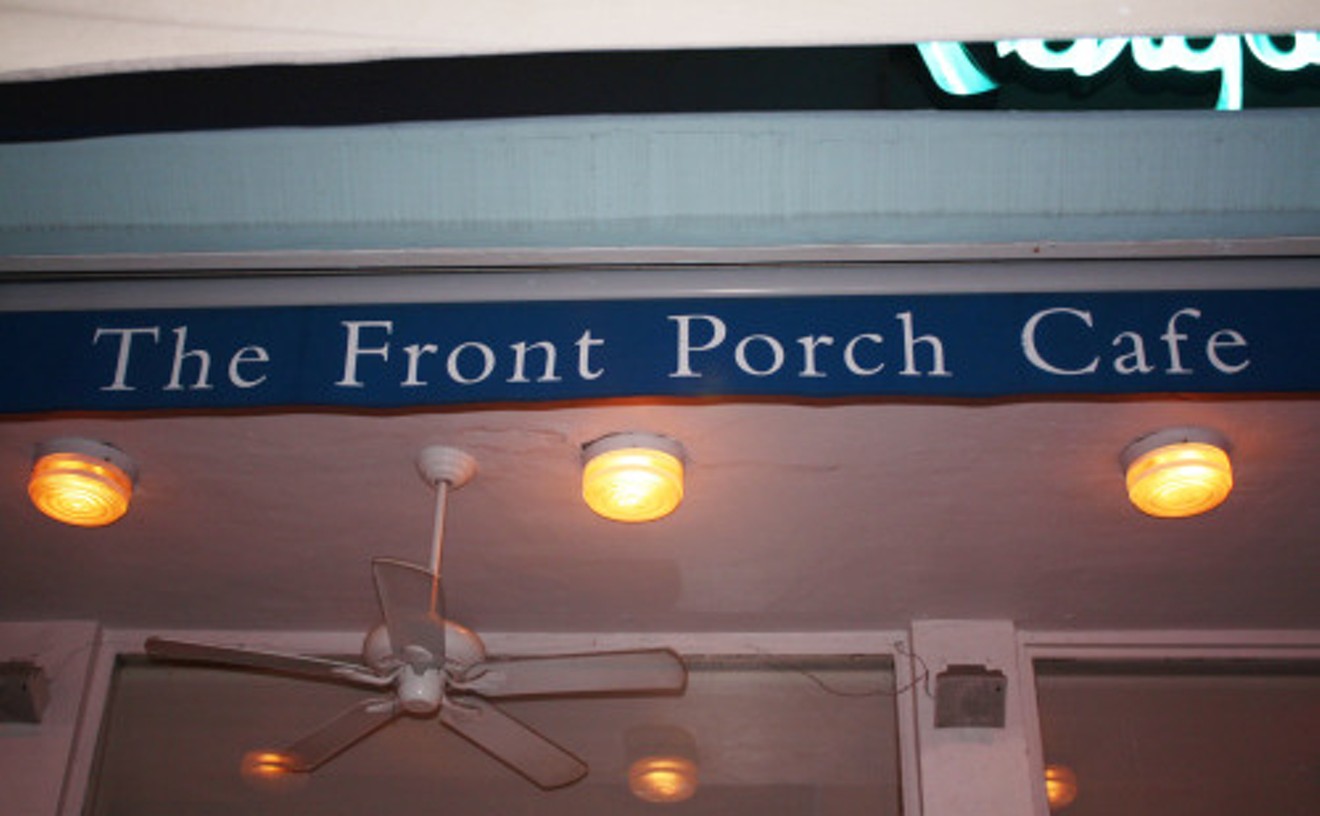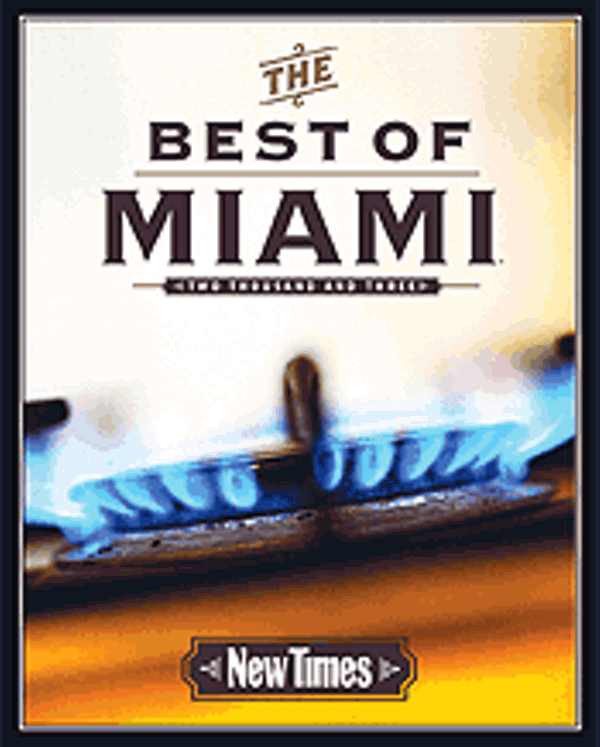BEST ART GALLERY
Locust Projects
- 297 NE 67th St., Miami, 33138 Map
- 305-576-8570
- locustprojects.org
BEST LOCAL GIRL MADE GOOD
Cecilia Altonaga
Readers Choice: Gloria Estefan
BEST ACTIVITY TO DO WHILE INTOXICATED
Sober up at Puerto Sagua
BEST VALUE ON OCEAN DRIVE
Front Porch Caf

- 1418 Ocean Dr., Miami Beach, 33139 Map
- 305-531-8300
- www.frontporchoceandrive.com
BEST HIDDEN NEIGHBORHOOD
Normandy IsleMiami Beach
BEST WEATHERCASTER
Don Noe
BEST NEW PLAY
Anna in the Tropics
BEST NOT-SO-CHEAP THRILL
Harley-Davidson rentalAmerican Road Collection
BEST CHARITY
Kiwanis Club of Little Havana
Michelle Bernstein
Personal Best
AZUL, 500 Brickell Key Drive (Mandarin Oriental Hotel), Miami ,305-913-8358
Michelle Bernstein is that rarest of Miami creatures: a true native. Which is why last year she was honored as Best Local Girl Made Good: "After working for others and then co-owning a short-lived but ambitious venture (The Strand), Bernstein took a major leap: She left South Beach for Brickell Key and the luxe Mandarin Oriental Hotel. Within a year Esquire magazine named her restaurant, Azul, the best of 2001. The Food TV network hired her to host a series on tropical foods. And the Vita-Prep people picked her for an advertisement that numero uno trade mag Food Arts featured prominently. Can any other native make that kind of claim to national fame?" So what's left to say? Well, only that Bernstein's Azul has since received the American Automobile Association's highest commendation: the Five Diamond Award. No other Miami-Dade restaurant can boast that distinction.
BEST PLACE FOR FRESH FRUIT
I probably sound like a princess for saying this, but Epicure is my favorite place for fruit. The colors are vibrant, the fragrance hits you when you walk in the door. What kills me is that I buy a huge amount of produce on a daily basis for the restaurant and I never get such beautiful fruit as Epicure does. Not just that, they get seasonal fruits before we do. I patiently wait for cherry season, plum and peach season, and sure enough, Epicure is loaded with not just the fruit I search out but specialty types like white cherries, sugar plums, and doughnut peaches. They make a honey tangerine juice that is addictive.
BEST MONTH TO BE IN MIAMI
Being a Miami native, there is definitely one month that sticks out in my mind: December. Where else can you spend Christmas on the beach? There is a certain magic in the air. The tourists are here scrambling for their SoBe purchases, the restaurants are boisterous and hopping, the sun is shining, and we have a total of, say, eight days to wear our best winter couture.
BEST PLACE TO SAVOR THE FLAVOR OF MIAMI
I cannot imagine showing off our city's flavors without first stopping at El Palacio de los Jugos. I marvel in their fruit juice selection (made to order), from sugar cane to tamarind to papaya-coconut. As you try to make a fruit-drink decision, the chicharrónes call out your name like a little devil on your shoulder. Take no more than two steps and the fresh mariquitas (thin slices of green plantain) are being thrown into the fryer. They're placed into a little bag so you can attack the crispy critters on your way home. But don't leave just yet -- the best part of this little jewel is the pan con lechon (shredded pork on bread). Ask for a little extra mojo while you're at it. Savoring these Latin flavors is part of our lifestyle; it's what I grew up with and what I live for.
BEST CHEAP THRILL
One of my greatest thrills in Miami is a very personal one. I started going down to Homestead when I was four, to the various U-pick fields, as I do today. First wed stop at the field where you can pick tomatoes, warm and fragrant from the vine. Then corn on large stalks and lettuces of different types. But the best part was (and is) the strawberries. Oh, the strawberries! A group of Old German Baptists run a place called Knaus Berry Farm, which has the sweetest, juiciest, biggest strawberries youve ever seen. The best part: Once youre done picking, you stop at the roadside stand to gorge on strawberry shakes made with fresh strawberry ice cream and the just-picked strawberries. Its the most intense frozen-strawberry smoothie you can ever imagine. But dont go anywhere yet. They also sell big hot cinnamon buns fresh from the oven.
BEST REASON TO LIVE IN MIAMI
There is one good reason why I'll probably always consider Miami my home: the passion. Our city is smoking hot from the sizzling sun, combined with beautiful people, zestful food, and a fusion of many different languages, cultures, and music. Behind all these is a passion that is incomparable. We cook with our hearts, dance with zeal, speak in voluminous tones. Our achievements are accomplished by following our hearts more than our minds. If we don't believe strongly in something, with our hearts and souls, it probably won't even be attempted. Our clothing is bright, our senses alive, and we strive to let ourselves show.
RECIPE
CHOCOLATE MOLE PAINTED FOIE GRAS OVER PORT GASTRIC BRAISED CHERRIES
1 teaspoon ground ancho chiles
1 teaspoon ground almonds
1/4 teaspoon ground cinnamon
Pinch of Hawaiian sea salt
1 cup extra-bitter chocolate, melted in a double boiler
Combine above ingredients and keep warm over hot water until just before serving; use a paintbrush to "paint" the mole onto a white plate.
In a pan, sear a 3-ounce piece of fresh foie gras. When golden, place foie gras into a cold pan, set aside.
In the hot pan with foie fat add:
1/4 cup pitted cherries
1/4 cup port wine
2 tablespoons red wine vinegar
1 tablespoon sugar
Reduce until it coats the back of a spoon.
Heat the foie gras in the oven at 350 degrees until medium rare to medium, approximately 3 to 4 minutes, until it feels soft when you press lightly on it. If there is hardness, heat for 2 more minutes. Glaze the foie gras with a little extra chocolate. Place 2 tablespoons of sauce in the center of the "painted" plate. Top with the chocolate-glazed foie gras. Top the foie with a little sea salt and serve immediately.





